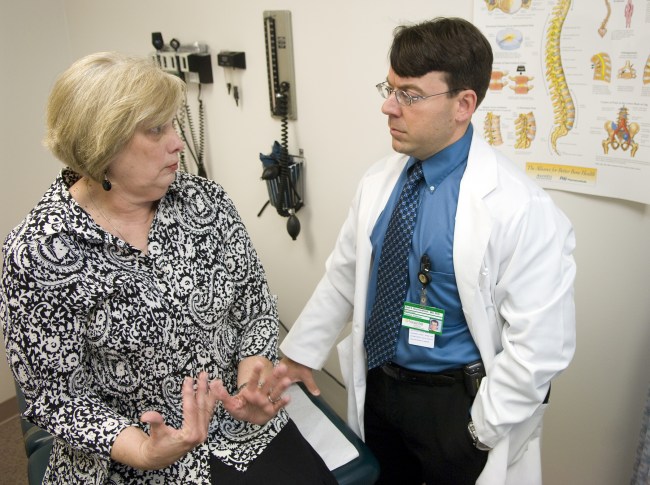
Chad Boomershine, M.D., speaks with patient Kay Good, in the Fibromyalgia Clinic. (photo by Susan Urmy)
New tools helps assess fibromyalgia severity
Patients with the pain disorder fibromyalgia are often labeled as hard to diagnose and difficult to treat, but Chad Boomershine, M.D., Ph.D., has devised an assessment tool to help physicians sort through all the symptoms and make an accurate diagnosis.
The problem, Boomershine said, is that patients with fibromyalgia have trouble articulating their symptoms. They present with widespread pain in addition to depression or anxiety, fatigue and insomnia. There is no lab test to make a definite diagnosis, and the patients do not respond to traditional pain medications, so physicians often become frustrated.
The assessment tool was developed with Leslie Crofford, M.D., from the University of Kentucky, and published as the cover story in the premier issue of Nature Reviews Rheumatology under the title “A symptom-based approach to pharmacologic management of fibromyalgia.”
The tool is the mnemonic FIBRO – F stands for fatigue, I for insomnia, B for blues (depression and anxiety), R for rigidity, O for ow! (pain). Patients rate their symptoms on a simple 0-10 scale, and physicians can easily tally the scores to form an overall picture of the disorder’s severity.
“Most physicians are comfortable with the issues individually, but when you put them all together in the same person, it gets a little overwhelming. So if you could break the symptoms down and deal with each individually, it makes it much easier for the physicians to treat the patients,” Boomershine said.
Patients with fibromyalgia have abnormalities in the brain that affect how they perceive pain, so treatments are aimed at altering the pain-sensing pathways.
“The volume control is turned up too high, and we have to turn the volume down,” Boomershine explained.
Fibromyalgia is more common in people with rheumatic conditions like arthritis or lupus. It is believed that patients are genetically predisposed and then the disease is triggered by a stressful event, such as a death in the family, an automobile accident or abuse.
Boomershine has tested the assessment tool in his own practice, which is the only dedicated fibromyalgia clinic in the state. He has also received a grant from Pfizer to use data from 1,500 patients to verify the tool.
The clinic began just over a year ago and demand was high, resulting in a 14-month waiting list until a nurse practitioner, Marni Groves, M.S.N., was hired. Now Boomershine sees new patients, makes the initial diagnosis and forms treatment plans. Groves sees the patients in follow-up until the disease is managed, and then they are transitioned back to their primary care physicians.
With the clinic established, Boomershine is now focused on making connections with other groups to improve referral and care. He is working closely with the Vanderbilt Center for Integrative Health and the Dayani Center to incorporate treatments including yoga, acupuncture and massage.
“You can’t just treat fibromyalgia with medicines,” Boomershine said. “You have to use medicines in addition to non-pharmacological treatments like exercise and psychology.”













